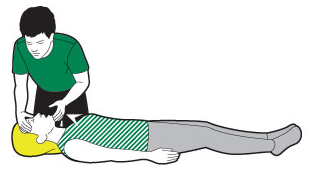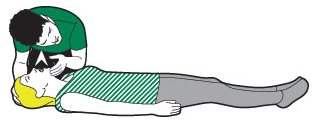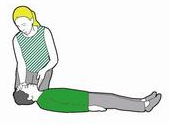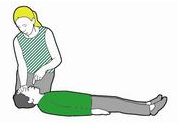Umgang mit einem Kind, das nicht ansprechbar ist
Begutachtet von Dr. Rachel Hudson, MRCGPZuletzt aktualisiert von Dr. Philippa Vincent, MRCGPZuletzt aktualisiert am 5. Dezember 2023
Erfüllt die Anforderungen des Patienten redaktionelle Richtlinien
- HerunterladenHerunterladen
- Teilen Sie
- Sprache
- Diskussion
In dieser Serie:Atembeschwerden bei Kindern
Wenn jemand nicht mehr reagiert, braucht er jemanden, der ihn in Sicherheit bringt und weiteren Schaden abwendet. Die Art der benötigten Hilfe hängt davon ab, warum die Person nicht mehr reagiert, ob sie atmet oder nicht und ob es sich um ein Baby, ein Kind oder einen Erwachsenen handelt.
In diesem Artikel:
Wenn ein Kind nicht reagiert, sollten Sie um Hilfe rufen und die Nummer 999 wählen. Vergewissern Sie sich, dass ein Krankenwagen auf dem Weg ist.
Bei Kindern ist die Durchführung von Beatmungsmaßnahmen (Notfallbeatmung) entscheidend für die Überlebenschancen des Kindes. Für Personen, die nicht in der pädiatrischen Wiederbelebung ausgebildet sind, ist es am wichtigsten, schnell Hilfe zu holen. In jedem Fall ist es wichtig, einen Krankenwagen zu rufen und sofort zu handeln.
Dieses Merkblatt wurde auf der Grundlage von Erste-Hilfe-Ratschlägen der St. John Ambulance, der landesweit führenden Erste-Hilfe-Organisation, erstellt. Diese Ratschläge sind kein Ersatz für einen Erste-Hilfe-Kurs - finden Sie einen Kurs in Ihrer Nähe.
Lesen Sie unten weiter
Nicht ansprechbar und atmend
Worauf ist zu achten?
Wenn ein Kind nicht auf Sie reagiert und Sie glauben, dass es nicht ansprechbar ist, fragen Sie laut: "Was ist passiert?" oder "Mach die Augen auf". Legen Sie eine Hand auf die Schulter des Kindes und klopfen Sie es sanft. Wenn es dann immer noch nicht reagiert, ist es wahrscheinlich nicht ansprechbar.
Was Sie tun müssen
Wenn Sie den Eindruck haben, dass Ihr Kind nicht reagiert, prüfen Sie, ob es noch normal atmet. Wenn Ihr Kind nicht reagiert und atmet, müssen Sie Folgendes tun:
Schritt 1 - Öffnen der Atemwege
Legen Sie eine Hand auf die Stirn des Kindes und neigen Sie den Kopf vorsichtig nach hinten. Dabei wird der Mund des Kindes leicht geöffnet.
Legen Sie die Fingerspitzen der anderen Hand auf die Kinnspitze des Kindes und heben Sie es an.
Öffnen Sie die Atemwege

Schritt 2 - Überprüfen Sie, ob das Kind normal atmet
Achten Sie auf die normale Atmung - Brustkorbbewegung, Atemgeräusche und Atemzüge an der Wange - und achten Sie darauf. Tun Sie dies nicht länger als zehn Sekunden.
Atmung prüfen

Wenn die Person normal atmet, bringen Sie sie in die stabile Seitenlage, um die Atemwege offen zu halten.
Schritt 3 - Bringen Sie sie in die Erholungsposition
Die nächsten drei Schritte werden durchgeführt, wenn das Kind auf dem Rücken liegt. Wenn das Kind auf der Seite oder auf dem Bauch liegt, sind möglicherweise nicht alle drei Schritte erforderlich.
Legen Sie den Arm, der Ihnen am nächsten ist, im rechten Winkel zum Körper ab, wobei die Handfläche nach oben zeigt.
Legen Sie den anderen Arm quer über die Brust, so dass der Handrücken an der Wange anliegt, die Ihnen am nächsten ist, und halten Sie ihn dort. Heben Sie mit der anderen Hand das andere Knie an und ziehen Sie es nach oben, bis der Fuß flach auf dem Boden steht.
Drehen Sie das Kind nun auf die Seite. Ziehen Sie vorsichtig an seinem gebeugten Knie und rollen Sie es zu sich hin. Dabei sollte der obere Arm den Kopf des Kindes stützen und das angewinkelte Bein auf dem Boden liegen, damit es nicht zu weit nach vorne rollt.
Erholungsposition

Vergewissern Sie sich als Nächstes, dass die Atemwege frei sind, damit das Kind atmen kann und die Flüssigkeit im Mund abfließen kann. Neigen Sie dazu den Kopf nach hinten, kippen Sie das Kinn vorsichtig nach vorne und stellen Sie sicher, dass die Atemwege offen und frei bleiben.
Schritt 4 - Wenn Sie eine Wirbelsäulenverletzung vermuten
Wenn Sie glauben, dass das Kind eine Wirbelsäulenverletzung haben könnte, müssen Sie versuchen, den Nacken des Kindes so ruhig wie möglich zu halten. Anstatt den Nacken zu kippen, sollten Sie die Kieferschubtechnik anwenden:
Legen Sie Ihre Hände auf beide Seiten des Gesichts und heben Sie mit den Fingerspitzen sanft den Kiefer an, um die Atemwege zu öffnen, ohne dabei den Hals zu bewegen.
Verdacht auf Wirbelsäulenverletzung

Schritt 5 - Um Hilfe bitten
Sobald Sie die Person sicher in die stabile Seitenlage gebracht haben, rufen Sie die Notrufnummer 999 oder 112 an.
Denken Sie daran, dass Sie bis zum Eintreffen von Hilfe immer wieder überprüfen müssen, ob die Person noch normal atmet.
Sollte die Atmung zu irgendeinem Zeitpunkt aussetzen, rufen Sie sofort die Nummer 999 oder 112 an und bereiten Sie sich darauf vor, den Betroffenen mit Herzdruckmassage und Beatmung wiederzubeleben.
Nicht ansprechbar und nicht atmend
Wenn ein Kind nicht auf Sie reagiert und Sie den Eindruck haben, dass es nicht ansprechbar ist, fragen Sie laut: "Was ist passiert?" oder sagen Sie: "Mach die Augen auf! Mach die Augen auf!". Legen Sie eine Hand auf die Schulter des Kindes und klopfen Sie es sanft. Wenn es dann immer noch nicht reagiert, ist es wahrscheinlich, dass es nicht ansprechbar ist.
Öffnen Sie die Atemwege und prüfen Sie, ob das Kind normal atmet. Achten Sie dabei auf die Bewegung des Brustkorbs, hören Sie auf normale Atemgeräusche und prüfen Sie, ob Sie die Atemzüge an Ihrer Wange spüren können.
Wenn die Person nicht atmet, müssen Sie sofort mit der Herz-Lungen-Wiederbelebung beginnen (eine Kombination aus Herzdruckmassage und Atemspende).
Was Sie tun müssen
Wenn jemand bei Ihnen ist, bitten Sie ihn, die Notrufnummer 999 oder 112 zu wählen.
Wenn Sie auf sich allein gestellt sind, müssen Sie eine Minute lang eine Herz-Lungen-Wiederbelebung durchführen, bevor Sie den Notarzt rufen. Dazu gehören Herzdruckmassage und Atemspende, um den Kreislauf des Kindes aufrechtzuerhalten.
Wiederbelebungsmaßnahmen bei einem Kind
Knien Sie sich neben das Kind auf den Boden, auf Höhe der Brust des Kindes.
Führen Sie fünf erste Beatmungen durch, bevor Sie mit der Abfolge von 30 Herzdruckmassagen und zwei Beatmungen beginnen.
Schritt 1 von 1
Stellen Sie sicher, dass die Atemwege des Kindes frei sind.
Kind mit offenen Atemwegen

Schritt 2 von 7
Kneifen Sie die Nase fest zu.
Kneifnase Kind

Schritt 3 von 7
Atmen Sie tief ein und schließen Sie Ihre Lippen um ihren Mund.
Blasen Sie gleichmäßig in den Mund, bis sich der Brustkorb hebt.
Rettungsatem Kind

Schritt 4 von 7
Nehmen Sie den Mund weg und lassen Sie die Brust fallen.
Atmendes Kind überprüfen

Geben Sie zwei weitere Beatmungshübe.
Führen Sie nun 30 Herzdruckmassagen durch.
Schritt 5 von 7
Legen Sie den Handballen einer Hand auf das Ende des Brustbeins in der Mitte des Brustkorbs und achten Sie darauf, dass die Finger nicht die Rippen berühren.
Beugen Sie sich mit gestrecktem Arm über das Kind, drücken Sie senkrecht auf das Brustbein und drücken Sie den Brustkorb um mindestens ein Drittel seiner Tiefe nach unten.
HLW-Fingerhaltung Kind

CPR Kind 1

Lassen Sie den Druck nach, ohne Ihre Hand von der Brust zu nehmen. Lassen Sie den Brustkorb wieder vollständig nach oben kommen - dies ist eine Kompression.
CPR Kind 2

Wiederholen Sie dies 30 Mal, etwa zweimal pro Sekunde oder in der Geschwindigkeit des Liedes "Staying Alive".
Geben Sie jetzt zwei Atemzüge.
Schritt 6 von 7 Um Hilfe bitten
Denken Sie daran, nach etwa einer Minute einen Notruf abzusetzen, wenn Sie auf sich allein gestellt sind.
Führen Sie 30 Herzdruckmassagen gefolgt von zwei Beatmungen durch, so lange Sie können oder bis Hilfe eintrifft. Wenn das Kind wieder normal zu atmen beginnt, beenden Sie die HLW und bringen Sie es in die stabile Seitenlage.
Hinweis: Diese Hinweise sind kein Ersatz für gründliche Kenntnisse in Erster Hilfe. Die St John Ambulance bietet landesweit Erste-Hilfe-Kurse an.
Das Copyright für dieses Faltblatt liegt bei St John Ambulance.
Patientenpicks für Erste Hilfe

Behandlung und Medikamente
Umgang mit einem Erwachsenen, der nicht ansprechbar ist
This leaflet is created from first aid advice provided by St John Ambulance, the nation's leading first aid charity. If someone becomes unresponsive they need someone to help keep them safe and prevent further harm. The type of help they need varies depending on why they have become unresponsive, whether they are breathing or not breathing and if they are baby, child or adult.
von Dr. Colin Tidy, MRCGP

Behandlung und Medikamente
Schnitte
Dieses Merkblatt gibt eine Anleitung, was Sie nach einer Schnittverletzung tun sollten.
von Dr. Doug McKechnie, MRCGP
Lesen Sie unten weiter
Artikel Geschichte
Die Informationen auf dieser Seite wurden von qualifizierten Klinikern verfasst und von Fachleuten geprüft.
Nächste Überprüfung fällig: 3. Dezember 2028
5 Dez 2023 | Neueste Version

Fragen, teilen, verbinden.
Stöbern Sie in Diskussionen, stellen Sie Fragen, und tauschen Sie Erfahrungen zu Hunderten von Gesundheitsthemen aus.

Fühlen Sie sich unwohl?
Beurteilen Sie Ihre Symptome online und kostenlos
Sign up to the Patient newsletter
Your weekly dose of clear, trustworthy health advice - written to help you feel informed, confident and in control.
By subscribing you accept our Privacy Policy. You can unsubscribe at any time. We never sell your data.